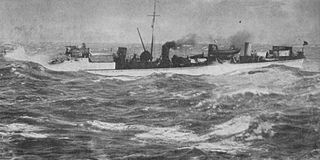
HMS Arab was a B-class torpedo boat destroyer of the British Royal Navy. She was laid down by J & G Thomson at Clydebank and completed by John Brown & Company who took over the yard.

The B class as designated in 1913 was a heterogeneous group of torpedo boat destroyers (TBDs) built for the Royal Navy in the late 1890s. They were constructed to the individual designs of their builders to meet Admiralty specifications, the uniting feature being a specified top speed of 30 knots (56 km/h) and four funnels, although the funnel spacings differed between ships. All "30 knotter" vessels with four funnels were classified by the Admiralty as the B class in 1913 to provide some system to the naming of HM destroyers. At the same time all "30 knotter" vessels with three funnels were classified by the Admiralty as the C class and those with two funnels became the D class.

HMS Quail was a B-class torpedo boat destroyer of the British Royal Navy. She was launched by Laird Brothers, Birkenhead, on 24 September 1895. She served in home waters and the West Indies for several years, her robust structure proved by surviving at least one heavy collision. She served during the Great War, and was sold off after the hostilities end, on 23 July 1919. She gave her name to the four strong group of Quail-class destroyers.

HMS Sparrowhawk was a B-class torpedo boat destroyer of the Royal Navy. She was completed by Laird, Son & Company, Birkenhead, and was launched on 8 October 1895. She served on the China Station and was wrecked in the mouth of the Yangtze River in 1904. She was one of four Quail-class destroyers.
HMS Thrasher was a "thirty-knotter" torpedo boat destroyer of the British Royal Navy. She was completed by Laird, Son & Company, Birkenhead, in 1897. One of four Quail-class destroyers, she served in the First World War, sinking the German submarine UC-39 in 1917, and was sold off after hostilities ended.

HMS Express was a B-class torpedo boat destroyer of the British Royal Navy. She was completed by Laird, Son & Company, Birkenhead, in 1896. Like many contemporary British destroyers, she was a "builder's special", designed to Admiralty specifications but built to the builder's own design.
HMS Wolf was a B-class torpedo boat destroyer of the British Royal Navy. She was completed by Laird, Son & Company, Birkenhead in 1897.
HMS Seal was a B-class torpedo boat destroyer of the British Royal Navy. She was completed by Laird, Son & Company, Birkenhead, in 1897.
HMS Panther was a B-class torpedo boat destroyer of the British Royal Navy. She was completed by Laird, Son & Company, Birkenhead, in 1897.
HMS Locust was a B-class torpedo boat destroyer of the British Royal Navy. She was launched by Laird, Son & Company, Birkenhead, on 5 December 1896. She served in the Mediterranean between 1902 and 1906, and was used for patrol and escort duties during the First World War
HMS Griffon was a B-class torpedo boat destroyer of the British Royal Navy. She was completed by Laird, Son & Company, Birkenhead, in 1896.
HMS Earnest was a "thirty-knotter" torpedo boat destroyer of the British Royal Navy. She was built by Laird, Son & Company at their Birkenhead shipyard as one of six Earnest-class destroyers ordered as part of the Royal Navy's 1895–1896 construction programme, which were later classified as members of the B-class. Earnest was launched on 7 November 1896 and was completed in November 1897.
HMS Lively was a B-class torpedo boat destroyer of the British Royal Navy. She was built speculatively by Laird, Son & Company, Birkenhead, pre-empting further orders for vessels of this type, and was bought by the navy in 1901.
HMS Sprightly was a B-class torpedo boat destroyer of the British Royal Navy. She was built speculatively by Laird, Son & Company, Birkenhead, pre-empting further orders for vessels of this type, and was purchased by the navy in 1901.
HMS Orwell was a B-class torpedo boat destroyer of the British Royal Navy. She was built by Laird, Son & Company, and served from 1900 until 1920.

HMS Lynx was a Ferret-class destroyer which served with the Royal Navy. She was launched in 1894 and sold in 1912.

The Banshee class was a class of three torpedo boat destroyers that served with the Royal Navy into the early part of the Twentieth century.

HMS Banshee was one of three Banshee-class destroyers which served with the Royal Navy.
HMS Leven was a Fairfield "30-knotter" destroyer of the Royal Navy, later classified as part of the C class. It was built in 1898–1899, and served with the Royal Navy through to the First World War, sinking a German U-boat in 1918. Leven was sold for scrapping in 1920.

HMS Fame was a two funnel, 30 knot destroyer of the Royal Navy, ordered under the 1894–1895 Naval Estimates. She was launched in 1896, served exclusively in Chinese waters and was sold at Hong Kong in 1921.








